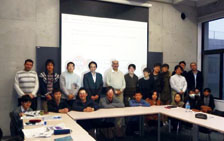Events
GCOE seminar on Structures in Fire・from Cardington to 9/11/2001 and beyond
Date: December 14, 2012 (14:45 - 16:00)
Venue: Kyoto University Katsura Campus Building C2, Room 213 (2nd floor)
Organized by:
Kyoto University Global COE Program "Global Center for Education and Research on Human Security Engineering for Asian Megacities"
Co-organized by:
Kyoto University Inter-Graduate School Program for Sustainable Development and Survivable Societies
Number of attendants: 21 persons
Poster
Report 236 (including presentation materials)
Purpose
The purpose of this seminar is to learn about the mechanism of building collapse due to fire action. Referring to the UK’s experience on the development of engineering methodology, the concept of structural engineering against fire action is introduced. The history of development based on actual fires, large scale experiments are described, followed by the tragedy of WTC collapse. The needs for rational engineering approach are specified especially for tall and super-tall buildings. The participants learned about the history of battle between fire accidents and engineering approaches to cope with them.
Invited Speaker
Prof. Asif Usmani is the head of the Institute for Infrastructure & Environment, School of Engineering, the University of Edinburgh. His background is computational mechanics and engaged in education and research on structural behavior during normal use as well as during fire accidents. He is well-known as his computational methods for structural behavior and design against fire effect.
Achievement and Results
An overview of the structures in fire, research at the University of Edinburgh over the past 15 years was presented. Lessons learnt from the Cardington fire tests in the middle 90s and their implications on the practice of structural fire engineering in the UK will be presented. The tragic and unprecedented events of September 11, 2001 forced a re-examination of previous understandings and stimulated research on tall buildings. Edinburgh research has been about discovering possible inherent weaknesses in structural design of tall buildings (including WTC towers). The results from this work produced interesting insights on tall building response to multiple floor fires. Much of this and previous work has led to a strong effort towards developing performance based structural engineering methodologies for fire resistance of structures. A brief summary of this and some other major projects at Edinburgh will be presented at the end. Through this seminar, it was found that computational structural engineering in fire is becoming more and more popular in UK for designing structures especially tall and super-tall buildings. For those buildings, the traditional approach is not always effective. Fire scenarios including multi-story fires should be included for design of important buildings.

